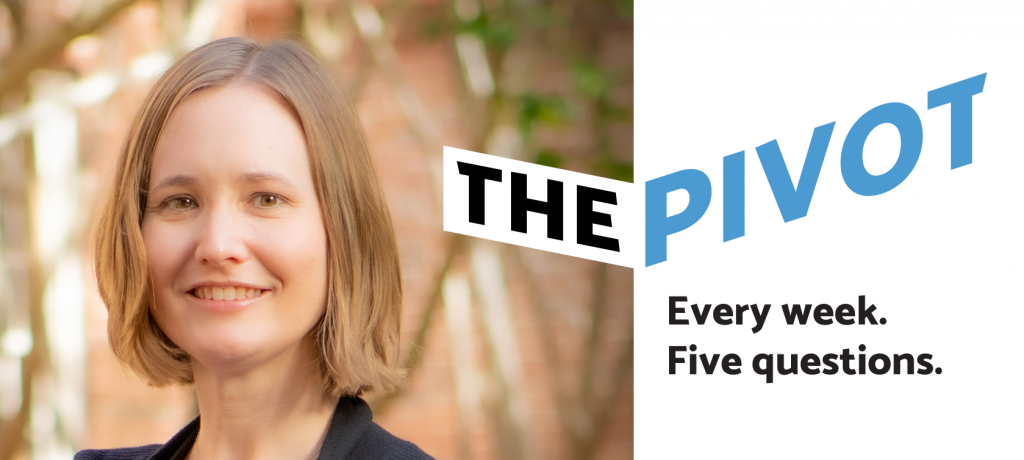
Dr. Bonnie Shook-Sa creates a more accurate picture of COVID-19’s impact.

What’s your role in public health?
I am an assistant professor in the Department of Biostatistics at UNC. I’m affiliated with the Collaborative Studies Coordinating Center (CSCC) and am a participating faculty member with the Center for AIDS Research (CFAR) Biostatistics Core. In these roles, I conduct both statistical methods research and collaborative research into infectious diseases — like HIV and COVID-19 — and health inequities.

Can you describe your focus area in one sentence?
I develop and apply statistical methods to improve understanding of public health challenges.
To elaborate, I conduct methodological research in the fields of causal inference and survey sampling, with a focus on methods for designing and analyzing data from observational studies and complex sample surveys. I apply these methods to collaborative public health studies across a range of disciplines, but I focus primarily on studies of health inequities and infectious diseases.

What brought you to public health?
I have always been a quantitatively minded person, and I’ve always had a passion for public health. I first took a biostatistics course during my undergraduate career — I was a mathematics major — and knew this was the field for me. The focus was much more applied than my other coursework, so I could really see the potential to use biostatistics to apply mathematical concepts and conduct research that would lead to increased understanding of public health challenges and improvements in public health.
After I received my master’s degree in applied statistics from The Ohio State University, I worked as a survey statistician for eight years in the nonprofit research sector, designing and analyzing data from complex sample surveys related to tobacco consumption, substance use, victimization and criminal justice. I came to UNC in 2016 to pursue my doctorate in public health and became motivated to work in infectious disease research.
My dissertation advisor, Dr. Michael Hudgens, motivated me to move into this field. I started working with him as a graduate research assistant with the CFAR Biostatistics Core, and I really enjoyed the research we conducted and saw its importance. So, I decided to focus my dissertation on infectious disease methods research.
During the pandemic, I’ve also been motivated to continue work in this area through collaborations with Drs. Ross Boyce, Allison Aiello and Audrey Pettifor. They are truly at the forefront of SARS-CoV-2 research, and I’ve seen the insights and positive impacts that have come from their research. I have learned and continue to learn so much from them. Seeing how the scientific community has responded to the coronavirus pandemic strengthens my commitment to the public health field and makes me even more proud to be a part of the Gillings School.

How have you pivoted in response to the coronavirus pandemic?
I was in my final semester of doctoral study when the pandemic arrived in the United States. I was also teaching the Sample Survey Methodology course in the biostatistics department. The pandemic led to changes in my work structure: My class transitioned to Zoom, as did my doctoral defense.
I graduated in May 2020, worked as a post-doc for a few months, and then transitioned to faculty in August. I stayed involved in many of the same research projects throughout this transition, but I also joined the CSCC, where I became a co-investigator on the Adolescent Medicine Trials Network for HIV/AIDS Interventions (ATN) and Hispanic Community Health Study/Study of Latinos (HCHS/SOL) projects. Both projects align well with my research interests in HIV (ATN) and survey sampling and health disparities (HCHS/SOL).
Prior to the pandemic, I worked primarily on HIV-related studies. When the pandemic started, it was natural to pivot to conducting SARS-CoV-2 research as well. I collaborated on studies related to estimating the prevalence of COVID-19 infections, transmission and vaccine uptake in the general population (the Chatham County COVID-19 Cohort) and among specific subpopulations like the UNC research community (the Return to Campus COVID-19 Assessment Project for UNC-CH Employees and Trainees, or ReCCAP UNC).
I also collaborated on the UNC Gillings COVID-19 Dashboard and a teacher survey related to COVID-19.

Who are you when you’re at home?
When I’m at home, I spend most of my time with my husband, six-year-old daughter and two dogs. We adopted one of our dogs right before the pandemic, so she has kept us entertained during this time. I also enjoy running and hiking, and I took up bike riding during the pandemic. My family just moved to Chapel Hill, so we have also been working a lot in our new garden. So far, we are growing flowers, carrots and lettuce.
